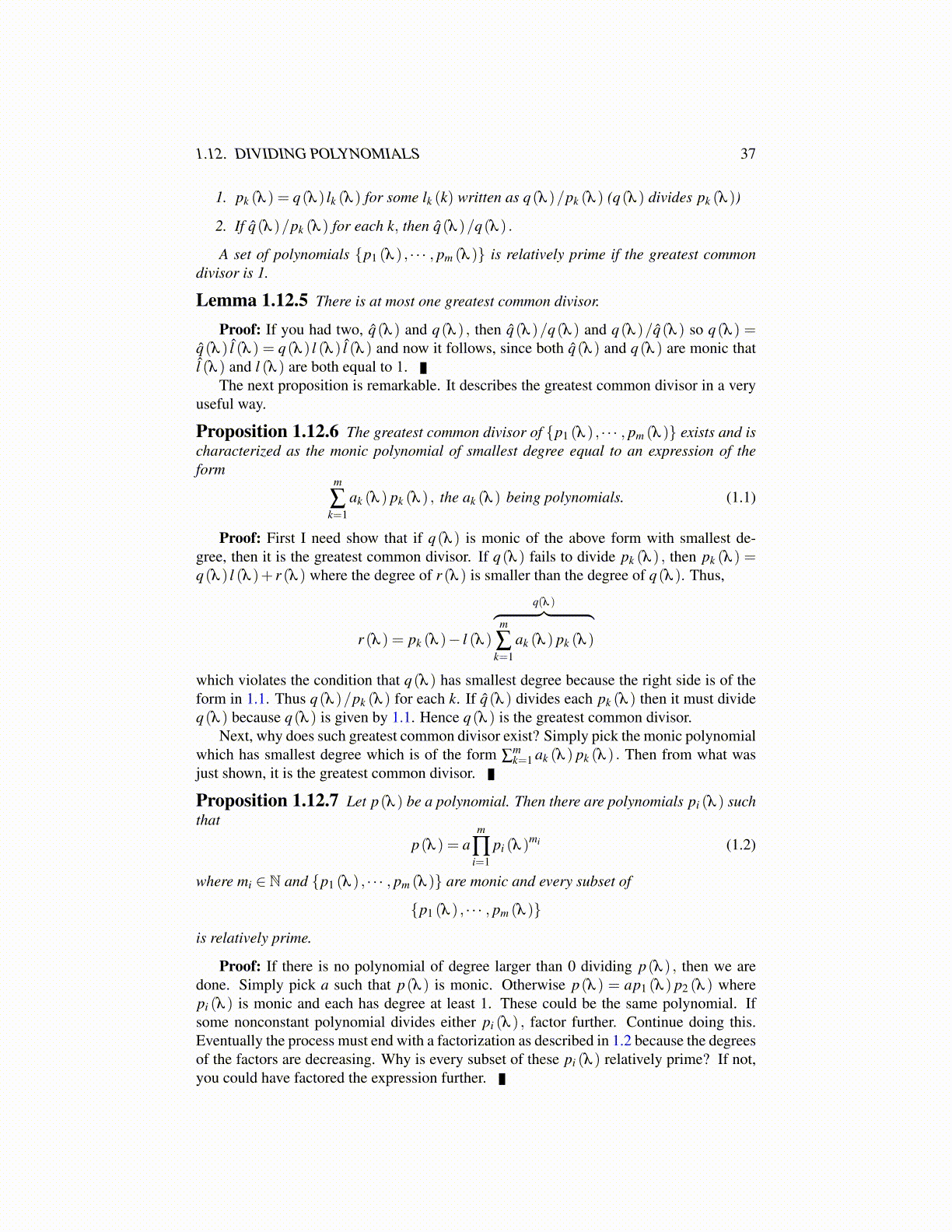
1.12. DIVIDING POLYNOMIALS 37
1. pk (λ ) = q(λ ) lk (λ ) for some lk (k) written as q(λ )/pk (λ ) (q(λ ) divides pk (λ ))
2. If q̂(λ )/pk (λ ) for each k, then q̂(λ )/q(λ ) .
A set of polynomials {p1 (λ ) , · · · , pm (λ )} is relatively prime if the greatest commondivisor is 1.
Lemma 1.12.5 There is at most one greatest common divisor.
Proof: If you had two, q̂(λ ) and q(λ ) , then q̂(λ )/q(λ ) and q(λ )/q̂(λ ) so q(λ ) =q̂(λ ) l̂ (λ ) = q(λ ) l (λ ) l̂ (λ ) and now it follows, since both q̂(λ ) and q(λ ) are monic thatl̂ (λ ) and l (λ ) are both equal to 1.
The next proposition is remarkable. It describes the greatest common divisor in a veryuseful way.
Proposition 1.12.6 The greatest common divisor of {p1 (λ ) , · · · , pm (λ )} exists and ischaracterized as the monic polynomial of smallest degree equal to an expression of theform
m
∑k=1
ak (λ ) pk (λ ) , the ak (λ ) being polynomials. (1.1)
Proof: First I need show that if q(λ ) is monic of the above form with smallest de-gree, then it is the greatest common divisor. If q(λ ) fails to divide pk (λ ) , then pk (λ ) =q(λ ) l (λ )+ r (λ ) where the degree of r (λ ) is smaller than the degree of q(λ ). Thus,
r (λ ) = pk (λ )− l (λ )
q(λ )︷ ︸︸ ︷m
∑k=1
ak (λ ) pk (λ )
which violates the condition that q(λ ) has smallest degree because the right side is of theform in 1.1. Thus q(λ )/pk (λ ) for each k. If q̂(λ ) divides each pk (λ ) then it must divideq(λ ) because q(λ ) is given by 1.1. Hence q(λ ) is the greatest common divisor.
Next, why does such greatest common divisor exist? Simply pick the monic polynomialwhich has smallest degree which is of the form ∑
mk=1 ak (λ ) pk (λ ) . Then from what was
just shown, it is the greatest common divisor.
Proposition 1.12.7 Let p(λ ) be a polynomial. Then there are polynomials pi (λ ) suchthat
p(λ ) = am
∏i=1
pi (λ )mi (1.2)
where mi ∈ N and {p1 (λ ) , · · · , pm (λ )} are monic and every subset of
{p1 (λ ) , · · · , pm (λ )}
is relatively prime.
Proof: If there is no polynomial of degree larger than 0 dividing p(λ ) , then we aredone. Simply pick a such that p(λ ) is monic. Otherwise p(λ ) = ap1 (λ ) p2 (λ ) wherepi (λ ) is monic and each has degree at least 1. These could be the same polynomial. Ifsome nonconstant polynomial divides either pi (λ ) , factor further. Continue doing this.Eventually the process must end with a factorization as described in 1.2 because the degreesof the factors are decreasing. Why is every subset of these pi (λ ) relatively prime? If not,you could have factored the expression further.